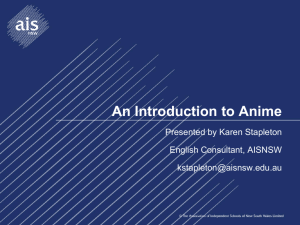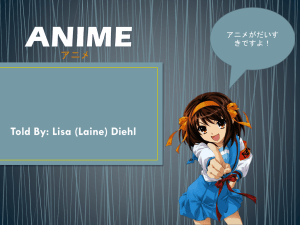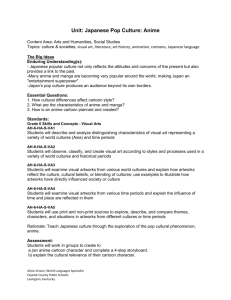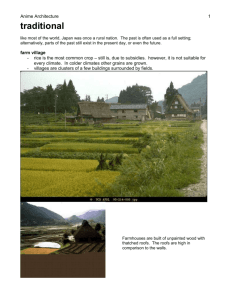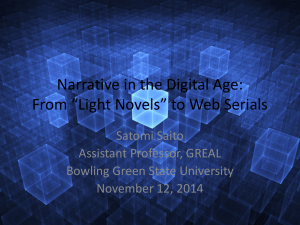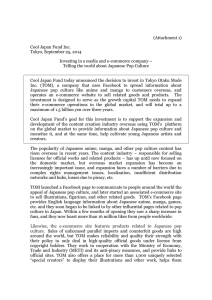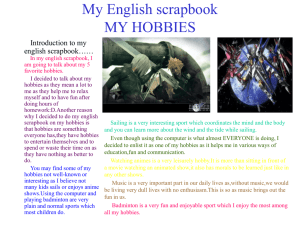An Introduction to Anime
advertisement
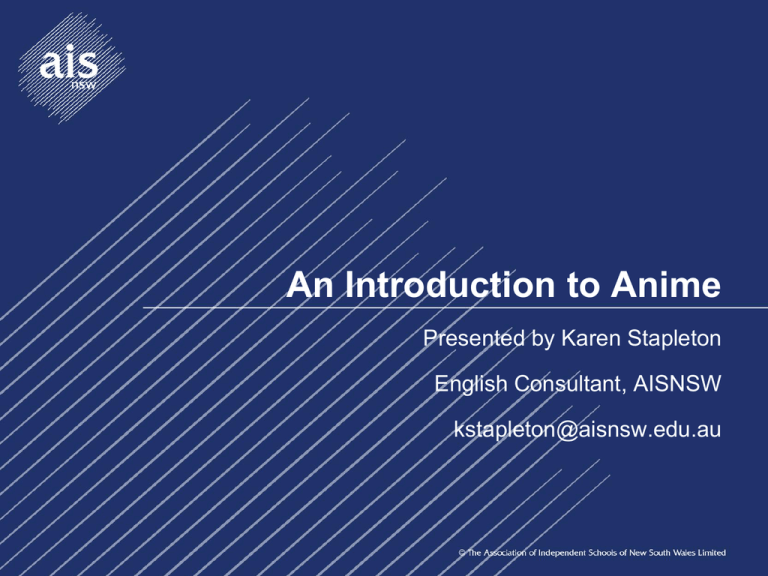
An Introduction to Anime Presented by Karen Stapleton English Consultant, AISNSW kstapleton@aisnsw.edu.au Presented by Karen Stapleton, AISNSW What is anime? Anime: (pronounced ah-nee-may) The term broadly refers to the shortened Japanese interpretation of the word Animation referring to animated moving-image films. More specifically Anime (which itself draws heavily on the Japanese printed comic tradition known as Manga) refers to a very specific style of Japanese cartoon-like animation. Anime emphasizes particular stylistic accents predominantly in relation to the depiction of human characters. Presented by Karen Stapleton, AISNSW Anime Has become THE major way in which non-Japanese are exposed to Japanese culture “Otaku” = fan anime films are NOT cartoons. Appeal to a broad audience now – note range of anime film classifications: PG R Sophisticated and complex films Presented by Karen Stapleton, AISNSW What’s great about anime Intricate plots and storylines Wide variety of topics, genres and styles strong emotive appeal – meant to ‘fire up’ emotions, responses importance of values in anime films eg sincerity, courage and perseverance. Quality of Artwork – concentrate on detail (rather than fluidity of motion); cinematic effects in artwork. Combines artistic expression and powerful entertainment Presented by Karen Stapleton, AISNSW Formats of anime TV episodes/ series OAV or OVA Original Animation Video: released as direct videos/DVDs for home rentals Full length feature films for cinema/theatre release Presented by Karen Stapleton, AISNSW How Anime evolved: The early, pre-TV era: 1917- 62 Originally based on fairy tales (Japanese + Western) Used same animation techniques as elsewhere in the world 1930s and during WW2 studios controlled and censored only able to produce propaganda or militaristic pieces Post war decade: industry in decline; lack of infrastructure/buildings etc growth of manga industry (cheaper) 1950s – revival of Japanese movie industry; “studio system” Presented by Karen Stapleton, AISNSW How Anime evolved - 1960s, a landmark decade for anime! Alakazam the Great (1960) - based on Osamu Tezuki’s comic book adaptation of ancient Monkey King legend; movie used his plot and visual style. Tezuki – most popular comic book artist (eg Astro Boy); regarded as having invented Japan’s modern ‘manga’ industry; pioneered many innovations in style and form and genre; incorporated many of the stylistic forms of film into his work TV animation studio, Mushi Productions founded by Osamu Tezuki in 1962. First TV anime, Astro Boy, released (preceded by a live-action show in 1959) Presented by Karen Stapleton, AISNSW How Anime evolved Tezuka’s influence: Popularity of TV animation Established the attitude that ‘cartooning’ was an acceptable form of storytelling for any age group Created sophisticated adult animation in a range of genres Pioneered artwork styles and techniques Productions represented the links: Manga live-action TV feature films Presented by Karen Stapleton, AISNSW How anime evolved – 1970s Flood of giant robot stories and toy-promotional features eg Tetsujin 28-GO TV series (in US “Gigantor”) – machine transformations; sci-fi genre Appearance, costumes etc influenced by samurai and Japanese martial arts traditions and hand-to-hand combat Great heroes and epic stories became prominent; more ‘theatrical releases’ based on Leiji Matsumoto’s manga tales of heroism, courage, humanity set against vast panorama of space and strange worlds Space operas! Presented by Karen Stapleton, AISNSW How anime evolved – 1980s Cinema/theatre anime challenges dominance of TV anime Development of anime storylines as well as expansion in genre and new ‘talents’ 1983 – release of the first OVA , Dallos, directed by Mamoru Oshii – his rise to fame! OVAs – led to new development in anime – the sexually explicit, erotic story (had long existed in manga). Popularity of films by Hayao Miyazaki and Isao Takahata: success of anime film, Nausicaa of the Valley of the Wind (1984) led to their establishment of Studio Ghibli Akira – 1988; set in dystopian Tokyo in 2019; huge impact on American audiences Presented by Karen Stapleton, AISNSW How anime evolved – 1990s Rise in anime production companies & greater global distribution As original viewers matured demanded more complex narratives and higher quality product Development of OVA/TV/movie crossover series Increased popularity of shojo anime (many based on CLAMP’s manga) Greater use of computers in animation Presented by Karen Stapleton, AISNSW TraditionalTop 5 Anime Studios & creators Studio Ghibli - Hayao Miyazaki (Spirited Away, Princess Mononoke) Production IG – Mitsuhisa Ishikawa (Ghost in the Shell, Kill Bill anime sequence) Gonzo - (Chrono Crusade, Last Exile, Hellsin, Final Fantasy) Gainax – Hideaki Anno (Neon Genesis Evangelion) Sunrise (Cowboy Bebop, Mobile Suit Gundam) - giant robots! Presented by Karen Stapleton, AISNSW Key elements in anime Manga is a major source for anime stories Distinctive character and background aesthetics that visually set it apart from other forms of animation Pacing and rhythm of the action; timing and editing Framing; camera & other cinematic effects used in the animation Visual structuring of the action/ detailed backgrounds Use of music; music can play a major role in the plot Presented by Karen Stapleton, AISNSW Key elements in anime Anime filmed and then voices are added Long narrative structures + twists and unpredictability of plot / endings / fate of characters etc. Characters (chara) are complex and multidimensional; their feelings are important in anime and shape their actions Inclusion of Japanese cultural details Use of comedy Presented by Karen Stapleton, AISNSW Main “chara” traits & visual conventions Chara are usually of mixed ancestry/race – don’t look Japanese even if action is set in Japan Hair – colour, shades, styles and movement. Waists – often slim, small, tiny for females and males, although some variation for men. Eyes – big, large, giant, non-Asian eyes are common Female breasts = often large, pert, bouncy - “defy gravity” Key thematic motifs = doll with a soul and/or cybernetic humans; giant robots
